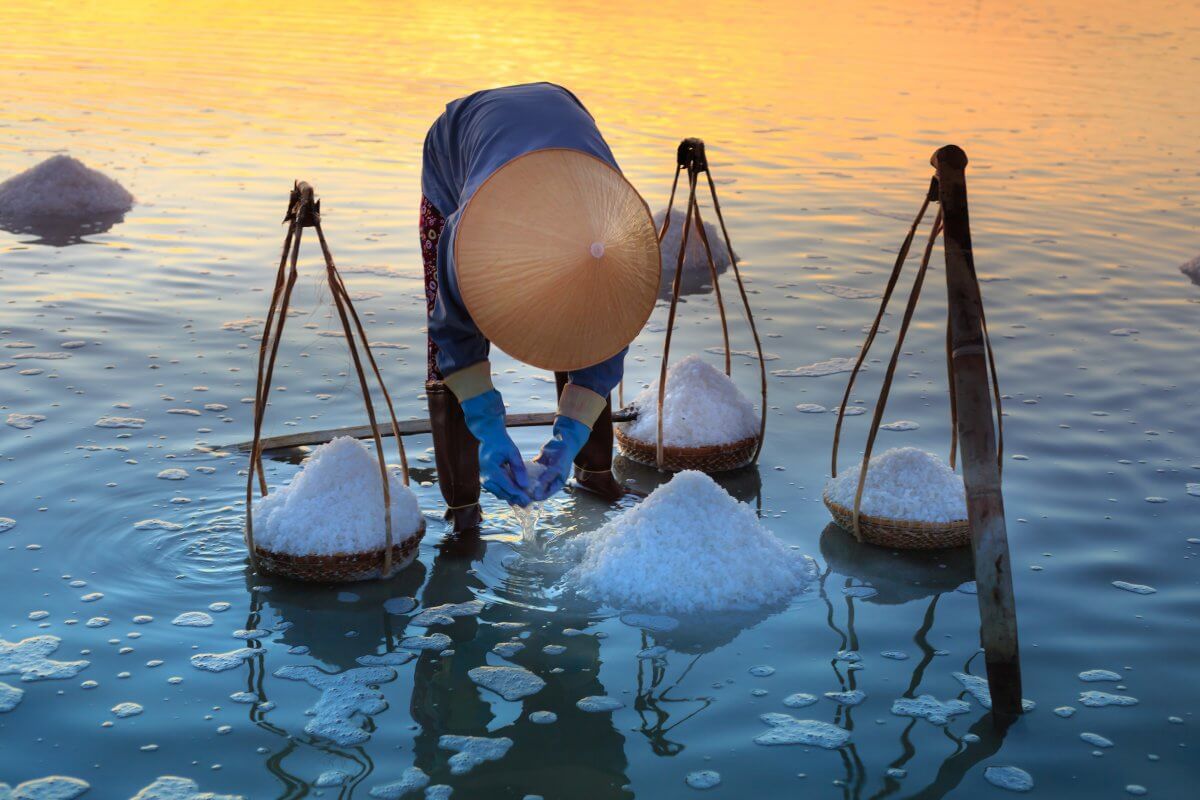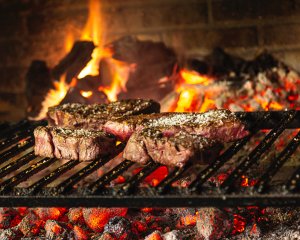Barbeque salt – should I use it?
Have you ever tried using barbeque salt? With so many flavors and varieties now available you can spice up meat, chicken, fish and vegetables all by sprinkling on a little flavored barbeque salt.
What is Barbeque salt?
BBQ salt, also known as barbeque or barbecue salt, is a type of seasoning that is typically used to add flavor to meats and vegetables. Generally, these are meats cooked on a grill or barbecue. It usually consists of a blend of salt, sugar, and spices such as paprika, garlic, onion, and black pepper. Some BBQ salt blends may also include smoky or savory flavors, which can enhance the taste of grilled foods. BBQ salt can be used as a rub or sprinkled on top of food before or after cooking. This adds a delicious and savory flavor to your barbecue dishes.
Which types of salt can I use on the barbeque?
When it comes to using salt on a barbecue, there are several options available. Here are a few of the most popular types of salt used for grilling:
- Kosher salt: This is a type of coarse-grained salt that is great for seasoning meat before grilling. It has a mild flavor and dissolves easily, making it perfect for coating meat.
- Sea salt: Made by evaporating seawater, sea salt contains trace minerals that can add flavor to grilled foods. It comes in a variety of textures, from fine to coarse. And it can be used as a finishing salt to add a final touch of flavor to grilled dishes.
- Himalayan pink salt: This salt is harvested from ancient sea salt deposits in the Himalayan Mountains and has a slightly sweet and delicate flavor. It’s perfect for seasoning meats and vegetables before grilling.
- Smoked salt: Salt infused with smoky flavors makes a great addition to barbecue rubs. Use as a finishing salt on grilled foods.
- Flavored salt: Supermarkets now offer an array of flavored salts ready to sprinkle on your meats. Think of delicious BBQ crispy chicken wings, or steaks covered in roasted garlic and chili spice. Oh quick, get the BBQ out now! And if you feel adventurous you could even try making your own if you prefer!
Ultimately, the type of salt you use will depend on your personal preference and the dish you’re preparing. Experiment with different types of salt to find the perfect flavor for your barbecue.
Should you salt meat before grilling?
Now for the science bit! When you salt meat, the salt draws out moisture from the meat through a process called osmosis. Osmosis is the movement of water molecules from an area of low salt concentration to an area of high salt concentration across a semi-permeable membrane, such as the cell membranes of the meat.
As the salt dissolves and penetrates the meat, it causes the proteins in the meat to denature, or unwind, which allows them to bind more tightly together. This gives the meat a firmer texture and helps it to retain its moisture during cooking. Additionally, the salt enhances the flavor of the meat by stimulating the taste buds on the tongue.
The length of time that the meat is salted, as well as the amount of salt used, can affect the texture and flavor of the meat. We recommend salting the meat at least 30 minutes before grilling. Over-salting the meat can lead to a dry, tough texture, while under-salting can result in a bland taste. In general, it is best to salt meat just before cooking or a few hours in advance. If you are grilling meats with their skins still intact then you can salt it overnight in the fridge. This will give you a lovely crispy skin and the meat will be well-seasoned.
Where does salt come from?
Salt comes from various sources, but the most common are:
- Salt mines: Some of the world’s largest salt deposits are found underground, in ancient seabeds or salt domes. These mines are located in countries such as the United States, Germany, China, Russia, and Canada.
- Saltwater: Most of the world’s salt comes from the oceans, where seawater is evaporated to leave behind salt crystals. This process is used to produce sea salt, which is prized for its unique flavor and texture.
- Salt lakes: Some inland lakes have high levels of salt due to evaporation and geological processes. The Great Salt Lake in Utah, for example, is one of the largest salt lakes in the world and is a significant source of salt for the United States.
- Brine: Brine is a solution of salt in water, and it can be found in salt pans or obtained by pumping water into underground salt deposits. Brine is then evaporated to produce salt crystals.
Once salt is obtained, it is typically refined and processed before being packaged and sold for consumption or industrial use. The exact method of refining and processing can vary depending on the type of salt and its intended use.

What else can salt be used for?
You don’t just have to use salt on a barbeque, there are loads of other ways in which to use it.
Cooking and Seasoning
Table salt is the most common type of salt used for cooking and seasoning food. Made up of small, uniform crystals the salt is usually white or slightly off-white in color. Table salt is typically made by mining salt deposits and then refining and processing the salt to remove impurities.
Table salt usually contains small amounts of additives, such as iodine or anti-caking agents, which are added to prevent clumping and to ensure that the salt flows freely out of a shaker or salt cellar. The iodine added to table salt is important for human health, as it helps to prevent iodine deficiency, which can lead to goiter and other health problems.
Table salt is a versatile ingredient that can be used in a wide variety of recipes. It is commonly used to season savory dishes, such as soups, stews, and roasted meats, as well as in baking and dessert recipes. However, it should be used in moderation, as excessive consumption of salt has been linked to high blood pressure and other health problems.
Baking
Most baking recipes that call for salt usually just refer to regular table salt. However, some baking recipes may call for a specific type of salt, such as kosher salt or sea salt, depending on the recipe and the desired flavor and texture of the finished product.
It is important to measure the amount of salt accurately when baking, as too much or too little salt can affect the taste and texture of the final product. In general, a good rule of thumb is to use about 1/2 to 1 teaspoon of salt per cup of flour in baking recipes.
It is also important to note that some baking recipes, such as bread recipes, may require a longer kneading time if using a coarser salt, such as kosher salt, as opposed to a finer salt like table salt. This is because coarser salts take longer to dissolve and distribute evenly in the dough
Curing
Curing salt, also known as Prague powder or pink salt, is a mixture of table salt and sodium nitrite. It is commonly used in meat curing to preserve the color and flavor of meat while preventing bacterial growth.
Curing salt is usually dyed pink to avoid confusion with regular table salt. It is used in small quantities and is not intended to be used as a table salt substitute. Instead, it is typically used in recipes that require curing, such as bacon, ham, and other cured meats.
Curing salt is effective at preventing the growth of Clostridium botulinum, a bacterium that can cause botulism, a potentially life-threatening illness. It also helps to enhance the flavor of cured meats and gives them their distinctive pink color.
It is important to note that curing salt should be used in the correct quantities and according to a recipe. Excessive consumption of nitrites can be harmful to human health. Remember to handle curing salt with care and keep it out of reach of children and pets, as it can be toxic if ingested in large amounts.
Pickling salt is a type of salt that is specifically used in the pickling process to preserve vegetables and fruits. It is a pure granulated salt that does not contain any additives, such as iodine or anti-caking agents, which can cause discoloration or cloudiness in the pickling liquid.
Pickling
Pickling salt is used to create a brine solution that is poured over vegetables or fruits to preserve them. The salt helps to draw moisture out of the vegetables, which is important for the preservation process. It also helps to prevent the growth of harmful bacteria that can spoil the pickled food.
One of the benefits of using pickling salt over regular table salt in pickling recipes is that it dissolves quickly and evenly in the brine solution. This ensures that all of the vegetables are evenly salted. Additionally, pickling salt has a finer grain size than most other salts, which makes it easier to measure and mix.
It is important to note that pickling salt should not be used as a substitute for table salt in cooking. This is because it does not contain iodine, an important nutrient for human health.
Summary
Salt is a versatile product and by adding herbs and spices such as garlic, chilies, thyme, nutmeg, etc. you can create unique flavors of barbeque salt. Jut match these to your meats, chicken, fish and vegetables and you will create a memorable barbeque.
More ideas
Do you still want to learn more? Then why not head over to our other sections to find out more about salt, its uses, other salt products, and some quick and easy recipes?
